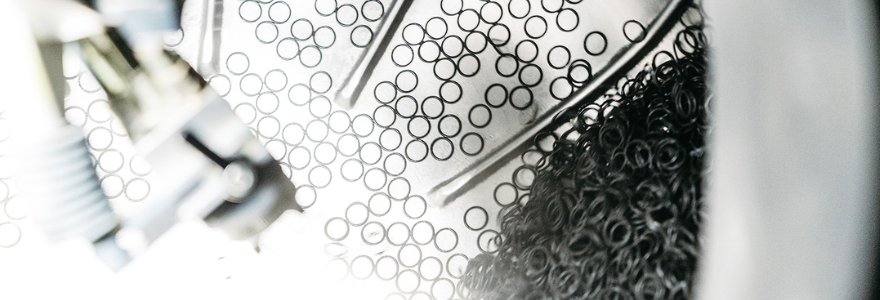Surface treatment- Coating

For many applications, standard seals cannot be used without surface treatment first We offer several coatings or treatments enabling:
- Facilitating manual and automatic assembly of the seals
- Improving the friction force of the seals for dynamic applications
- Easily identifying and easily customising seals
SURFACE TREATMENTS FOR REDUCED FRICTION DURING ASSEMBLY AND IN DYNAMIC APPLICATIONS
DuriCoat coating
DuriCoat incorporates several types of standard or high-tech PTFE-based coatings applied to the surface of the elastomer in a homogeneous way. These dry treatments can be translucent or coloured (Green, Blue, Purple, Red...), with or without UV indicator.
SiliCoat coating
SiliCoat is a coating in the form of an oily lubricating film based on liquid silicone which is applied to the surface of the elastomer by tumbling. It can be used on all types of elastomers except silicones (VMQ, FVMQ, PVMQ) except in special cases. It makes it possible to reduce assembly loads but cannot be used long term for dynamic applications. Considering the fact that the seals tend to stick to each other, it is not recommended to use this coating for automatic assembly.
PolyCoat coating
PolyCoat incorporates several types of water-based or solvent-based polysiloxane (dry silicone) coatings depending on the application, applied to the elastomer surface by spraying. It can be used on all types of elastomers except silicones (VMQ, FVMQ, PVMQ) except in special cases.
TalCoat coating
Talc in powder form is applied to the elastomer surface in a drum. This process prevents components from sticking to each other after packaging. It is not suitable for dynamic applications
MosCoat coating
MosCoat is a coating in the form of a dry lubricating film applied to the surface of the elastomer
|
Reference |
CTC001 |
CSL001 |
CPN001 |
CDP001 |
CDP002 |
CDP002 |
CDP003 (subcontracted) |
CDP007 |
|---|---|---|---|---|---|---|---|---|
|
Based |
Talc |
Polysiloxane |
Thermosetting polysiloxane |
PTFE |
Thermosetting PTFE |
Thermosetting PTFE |
Thermosetting PTFE |
Thermosetting PTFE |
|
Color |
White |
Transparent |
Transparent |
Transparent |
Transparent |
Blue, Green, Yellow, Red, Black, White |
Transparent white |
Transparent |
|
Aspect |
Dry |
Fat |
Dry |
Dry |
Dry |
Dry |
Dry |
Dry |
|
Powder |
Shiny |
Mast |
Shiny |
Shiny |
Shiny |
Mast |
Mast |
|
|
Smooth |
Smooth |
Smooth |
Smooth |
Smooth |
Smooth |
Smooth |
||
|
Thickness |
5-10 μm |
5 μm |
5-15 μm |
5-15 μm |
5-15 μm |
20-30 μm |
5-15 μm |
10-15 μm |
|
Detection |
Samples |
Samples |
UV indicator |
UV indicator |
UV indicator |
UV indicator |
Samples |
Samples |
|
Temperature |
-180°C |
-40°C |
-70°C |
-180°C |
-70°C |
-70°C |
-40°C |
-40°C |
|
Approval |
/ |
/ |
/ |
/ |
/ |
/ |
/ |
NSF H1DVGW W270ACSWRAS |
|
Frictional property ISO 15113 (NBR70 control = 1.08) |
/ |
0.53 |
0.53 |
0.32 |
0.52 |
0.35 |
0.75 |
0.40 |
|
Elastomer compatibility |
All elastomers |
All elastomers |
ACM, AEM, EPDM, FKM, FVMQ, HNBR, VMQ, NBR |
ACM, AEM, EPDM, FKM, FVMQ, HNBR, VMQ, NBR |
ACM, AEM, EPDM, FKM, FVMQ, HNBR, VMQ, NBR |
ACM, AEM, EPDM, FKM, FVMQ, HNBR, VMQ, NBR |
ACM, AEM, EPDM, FKM, FVMQ, HNBR, VMQ, NBR |
ACM, AEM, EPDM, FKM, FVMQ, HNBR, VMQ, NBR |
|
Auto power |
+ |
+ |
+++ |
+++ |
+++ |
+++ |
+++ |
+++ |
|
Separation |
||||||||
|
Assembly assistance |
+ |
+ |
++ |
+++ |
++ |
++ |
+++ |
++ |
|
Anti stick-slip |
+ |
0 |
++ |
+++ |
++ |
++ |
+++ |
++ |
|
Dynamic application |
0 |
0 |
+ |
+ |
++ |
++ |
+ |
+ |
